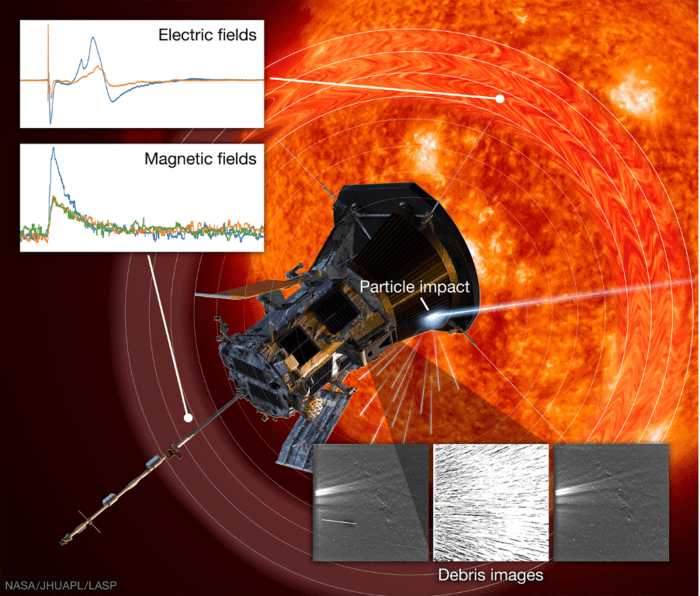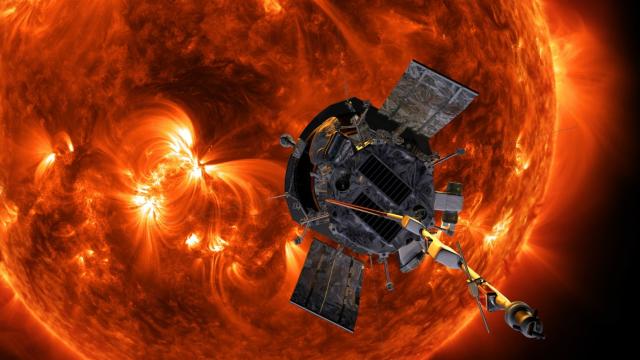NASA’s historic mission to “touch the Sun” has encountered a heavy bombardment of dust, surprising mission scientists and resulting in some fascinating new data about the Parker Solar Probe’s increasingly hostile environment.
Launched in 2018, the Parker Solar Probe has now completed nine of its 24 planned stellar orbits. Each orbit takes the spacecraft increasingly closer to the Sun, allowing for unprecedented scientific observations of our host star’s solar winds and outer corona. The probe will eventually succumb to the Sun’s intense heat and radiation, but that shouldn’t happen for another four years.
Thought it’s still early in its mission, working conditions for the spacecraft are starting to get a bit intense. Tiny grains of dust are increasingly slamming into the high-speed probe, resulting in plasma explosions and debris clouds. The constant collisions are now having a measurable effect on the probe and its ability to do work, but scientists aren’t expecting these impacts to threaten the mission. These findings will be presented later this week at the 63rd Annual Meeting of the APS Division of Plasma Physics in Pittsburgh.
That the Parker Solar Probe would encounter interplanetary dust, and that this dust might interfere with its scientific measurements, was predicted. Other spacecraft, like the Voyager probes, encountered similar environments, but Parker mission scientists didn’t anticipate the high number and severity of the impacts, nor the plasma explosions and resulting damage to the probe (even if minor at this point). The good news is that these observations are producing new science, while also demonstrating that Parker was built to survive.
“These observations are ‘happy surprises’ in that the impact explosions produce clouds of material so dense that we can watch fundamental solar wind physics operate in a way that would not be possible otherwise,” David Malaspina, a research scientist from the Laboratory for Atmospheric and Space Physics at the University of Colorado, explained in an email. “They are also ‘happy surprises’ in that the impacts so far have not been large enough to overcome the dust impact shielding designed into much of the Parker Solar Probe spacecraft.”
NASA specifically asked for this investigation: to review predictions of catastrophic dust damage in light of newly recorded data coming from the probe. The team investigated the biggest dust strikes, namely the “ones that release the most energy, disrupt spacecraft measurements the most severely, and [dislodge] the most spacecraft debris,” Malaspina explained.

Evidence of the hypervelocity impacts were recorded by the probe’s magnetic field sensors and on-board cameras. The offending dust is very small, measuring between 2 and 20 microns in diameter, which is less than a quarter of the width of human hair. But the problem isn’t the size of the grains — it’s the speed at which they’re striking the spacecraft.
The Parker Solar Probe is the fastest human-made object ever built, with a heliocentric velocity (i.e. speed relative to the Sun) reaching 643,738 km per hour. Dust particles are slamming into the probe at speeds in excess of 11,265 km per hour, causing them to vaporise and then ionize on contact (ionization happens when atoms get separated into ions and electrons, resulting in that funky state of matter known as plasma). The ensuing plasma explosion lasts for less than one-thousandth of a second, the largest of which spawn clouds of debris that drift away from the probe.
The team detected these disturbances in Parker’s electromagnetic environment, but evidence of the collisions was seen elsewhere in the form of data artifacts; metallic flakes and paint chips are being knocked loose during the collisions, and this debris is creating streaks in images taken by the probe’s navigational and scientific cameras.
The total number of collisions now number in the tens of thousands, and the probe has endured intense periods during which it was struck by hypervelocity dust grains once every 12 seconds on average, according to Malaspina. Most impacts aren’t producing debris and dense plasma clouds, but the team did manage to identify around 250 very high-energy impacts that occurred during Parker’s first eight orbits of the Sun.
The increasing volume of impacts is a function of Parker Solar Probe’s speed. Malaspina likened it to driving through a rainstorm: “The faster you drive, the more intensely the rain hits the windshield,” he said. Even so, Parker’s measurements of dust density in the inner solar system has revealed more dust than expected, Malaspina added.
To date, the impacts haven’t inflicted any catastrophic damage onto the probe. Parker’s 11.43 cm thick carbon-composite shield has a lot to do with this, as the spacecraft can withstand external temperatures reaching nearly 1,371°C. That said, an energetic particle instrument is beginning to degrade; the impacts have punched a hole through the device, “allowing sunlight to reach the instrument’s sensitive detectors, and driving up their noise levels,” Malaspina explained. But he’s not worried. Even taking the greater density of dust into account, “the updated predictions for the probability of catastrophic failure suggest that there is a high probability — but not 100% — that Parker Solar Probe will survive all 24 planned orbits,” he said.
This is great news, but the worst is yet to come. Parker’s final three orbits will see the probe come to within 6.12 million km of the Sun’s surface, at which point its heat shield will truly be put to the test. We can’t wait.
